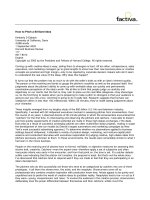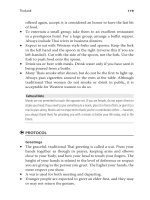Tài liệu How to Motivate Every Employee- 24 Proven Tactics to Spark Productivity in the Workplace docx
Bạn đang xem bản rút gọn của tài liệu. Xem và tải ngay bản đầy đủ của tài liệu tại đây (781.95 KB, 65 trang )
TEAMFLY
Team-Fly
®
“In thinking about motivation from a
management perspective, it’s very impor-
tant to appreciate this point: You can’t
motivate people, you can only influence
what they’re motivated to do.”
This page intentionally left blank.
“When you look at personal growth as a
motivator, you change the way employees
think about their work, you help them
become more capable, and you give them a
meaningful purpose in coming to work.”
This page intentionally left blank.
How to Motivate
Every Employee
24 Proven Tactics to Spark
Productivity in the Workplace
A
NNE
B
RUCE
M
C
G
RAW
-H
ILL
New York Chicago San Francisco Lisbon
London Madrid Mexico City Milan New Delhi
San Juan Seoul Singapore Sydney Toronto
Copyright © 2003 by The McGraw-HIll Companies, Inc. All rights reserved. Manufactured in the
United States of America. Except as permitted under the United States Copyright Act of 1976, no part
of this publication may be reproduced or distributed in any form or by any means, or stored in a data-
base or retrieval system, without the prior written permission of the publisher.
0-07-143152-7
The material in this eBook also appears in the print version of this title: 0-07-141333-2
All trademarks are trademarks of their respective owners. Rather than put a trademark symbol after
every occurrence of a trademarked name, we use names in an editorial fashion only, and to the benefit
of the trademark owner, with no intention of infringement of the trademark. Where such designations
appear in this book, they have been printed with initial caps.
McGraw-Hill eBooks are available at special quantity discounts to use as premiums and sales promo-
tions, or for use in corporate training programs. For more information, please contact George Hoare,
Special Sales, at or (212) 904-4069.
TERMS OF USE
This is a copyrighted work and The McGraw-Hill Companies, Inc. (“McGraw-Hill”) and its licensors
reserve all rights in and to the work. Use of this work is subject to these terms. Except as permitted
under the Copyright Act of 1976 and the right to store and retrieve one copy of the work, you may not
decompile, disassemble, reverse engineer, reproduce, modify, create derivative works based upon,
transmit, distribute, disseminate, sell, publish or sublicense the work or any part of it without McGraw-
Hill’s prior consent. You may use the work for your own noncommercial and personal use; any other
use of the work is strictly prohibited. Your right to use the work may be terminated if you fail to com-
ply with these terms.
THE WORK IS PROVIDED “AS IS”. McGRAW-HILL AND ITS LICENSORS MAKE NO
GUARANTEES OR WARRANTIES AS TO THE ACCURACY, ADEQUACY OR COM-
PLETENESS OF OR RESULTS TO BE OBTAINED FROM USING THE WORK, INCLUDING
ANY INFORMATION THAT CAN BE ACCESSED THROUGH THE WORK VIA HYPER-
LINK OR OTHERWISE, AND EXPRESSLY DISCLAIM ANY WARRANTY, EXPRESS OR
IMPLIED, INCLUDING BUT NOT LIMITED TO IMPLIED WARRANTIES OF MER-
CHANTABILITY OR FITNESS FOR A PARTICULAR PURPOSE. McGraw-Hill and its licensors
do not warrant or guarantee that the functions contained in the work will meet your requirements or
that its operation will be uninterrupted or error free. Neither McGraw-Hill nor its licensors shall be
liable to you or anyone else for any inaccuracy, error or omission, regardless of cause, in the work or
for any damages resulting therefrom. McGraw-Hill has no responsibility for the content of any infor-
mation accessed through the work. Under no circumstances shall McGraw-Hill and/or its licensors be
the use of or inability to use the work, even if any of them has been advised of the possibility of such
damages. This limitation of liability shall apply to any claim or cause whatsoever whether such claim
or cause arises in contract, tort or otherwise.
liable for any indirect, incidental, special, punitive, consequential or similar damages that result from
DOI: 10.1036/0071431527
How to Motivate Every Employee viii
Build a motivated workforce 1
They do it for themselves 3
Know what drives people 5
Make employees feel like partners 7
Show employees how the business operates 9
Know your competition 11
Encourage intelligent risk taking 13
Inspire creative and innovative thinking 15
Affirm the link between motivation
and performance 17
Help them achieve greater performance 19
Get employees to buy into your ideas—
and theirs 21
Be clear about rewards and recognition 23
Always expect the best from employees 25
Fire up successful performance 27
Offer incentives and morale boosters 29
Give your power away 31
Encourage accountability at all times 33
Build trust for a better tomorrow 35
Boost morale 37
Make it fun to make it motivating 39
Attack de-motivators head on 41
Retain your employees 43
Put heart and soul into your team 45
Unleash the power of human potential 47
Contents
vii
For more information about this title, click here.
Copyright 2003 by The McGraw-Hill Companies, Inc. Click Here for Terms of Use.
How to Motivate
Every Employee
✓
H
ow to Motivate Every Employee is a small but powerful book written
to help managers like you utilize in your career the actions and moti-
vational success strategies of world-class business icons, such as
Disney, SAS Institute, Virgin Management Limited, Levi Strauss,
Starbucks, Four Seasons Hotels, Capitol One, and more. In addition,
there are creative, timely, and immediately applicable tips, tools,
techniques, and suggestions—all presented in bite-size chunks—
guaranteed to keep you and your employees from falling victim to
mediocrity and complacency.
But, ultimately, none of these principles and innovative ideas will
be worth anything unless you can translate them into fast action
steps that affect your employees’ behaviors today—right now! This
book allows you to do just that.
Your expert skills and talents have gotten you this far. Now, let
this handy, user-friendly book help you apply the fast facts and quick
guidelines to becoming even more successful and effective—as a
motivating manager!
I believe in the power and the influence that today’s manager or
supervisor can have on employee motivation. With the right set of
techniques, like the ones included in this book, you can reawaken and
revive the spirit in your organization. Not only that, you can inspire all
those around you by creating an environment in which employees will
tap their own motivational energy and perform their best work.
viii
Copyright 2003 by The McGraw-Hill Companies, Inc. Click Here for Terms of Use.
It’s my hope that you will find 24 Ways to Motivate Every Employee
an invaluable workplace tool and resource that you’ll refer to again
and again. This is a book about managers creating an environment
in which their employees feel passionate about doing their jobs and
putting the best of themselves into those jobs. I hope you’ll feel pas-
sionate about the information in this book as well.
“Motivation is about cultivating your human capital. The
challenge lies not in the work itself, but in you, the per-
son who creates and manages the work environment.”
ix
H
ere’s the million-dollar question: Who would want to be influ-
enced and inspired by you? If you cannot answer this question, then
you have no business managing anyone. As a professional speaker
and corporate trainer, I have asked this question of thousands of man-
agers and leaders across America and abroad, and you’d be surprised
how difficult this question can be for some managers and supervisors
to answer. Oftentimes the response is simply a stunned hush.
Here’s why being able to answer this question is so important.
Managers can’t really do anything or be effective in their jobs, if
their employees aren’t motivated to perform well. So as a manager
or supervisor, it’s imperative that you continually look for ways to
engage your people and rouse their enthusiasm and commitment to
the organization and its goals.
The fact is that people are motivated to do what is in their best
interests. Your goal as a manager, then, is to help employees identify
their welfare with that of the organization. When this happens,
employees will naturally feel motivated to work hard, because it is in
their best interest to do so.
All this is another way of saying that motivation is intrinsic. It’s
what drives us to accomplish our desired ends. Whatever we do, it’s
always because we believe it will fulfill some present or future person-
al goal or desire.
1
Motivation isn’t your
problem
Build a motivated
workforce
✓
Copyright 2003 by The McGraw-Hill Companies, Inc. Click Here for Terms of Use.
TEAMFLY
Team-Fly
®
Contemplate this. When have you been most excited about your
work? For most people that excitement comes from being involved
with projects that were near and dear to us—projects we took person-
ally, or in which we believed we could really make a difference and
accomplish something for ourselves and others. By helping your
employees to identify closely with the job they are doing, you will
begin to reap the rewards of intrinsic motivation at work.
And when was the last time you thought about really trying to
“turn on” your organization? You’re the manager, right? Isn’t that
your job? Yes, but today motivation needs to be everyone’s responsi-
bility. As a manager, it is your job to help build a truly “motivating
organization,” one that inspires employees to do their very best every
day. Understanding that the role you play as a leader and manager
of people is one of extreme importance, here are three key points to
help build that motivating organization:
Know why your employees would want to be motivated by you:
When
you can answer this important question, you will be better equipped to
engage workers in their jobs more effectively and influence their behav-
iors to act more enthusiastically to meet company goals.
Recognize that real motivation is an inside job:
People talk about
motivation being either intrinsic or extrinsic. But it’s really only
intrinsic, within each of us. What we refer to as extrinsic motivation
is really just external factors, like company perks, bonuses, and pay
raises that ultimately affect our intrinsic motivation.
Turn employees on to what’s important and meaningful:
This
requires managers to inspire their followers to be their best, to take
risks, to think like entrepreneurs, and to unleash their limitless and
synergistic potential.
“Men and women want to do a good job, a creative job,
and if they are provided the proper environment, they
will do so.”
—Bill Hewlett, Co-founder, Hewlett-Packard
2
They do it for you
They do it for them-
selves
✓
A
s a manager, if you really want to influence people’s motivation,
you have to uncover their reasons for doing things. You have to ques-
tion their purposes and their causes. People aren’t going to be truly
motivated for your reasons and objectives. Employees ask themselves,
“What’s in it for me?” Knowing this upfront, it’s your responsibility
to find out what your employees’ motives are, then help them con-
nect those motives to your organization’s goals and activities. When
you do this, you also will be positively affecting each worker’s per-
formance on the job.
How do you know that you are doing this well? You’ll know when
your employees start asking the question, “What’s in it for us?” By
looking out for your people and their best interests, your employees
will begin to see that looking out for others and the organization as
a whole is how they ultimately look out for themselves. Sure, it can
take some time for this to happen, but if you persist, employees will
see the light and it will be worth the wait.
Most managers attempt to influence employee motivation using
both positive and negative approaches. As a manager or supervisor,
it is important that you understand clearly the three very different
techniques used to influence the motivation of people in today’s
workforce, and, thereby, evaluate their pros and their cons. By study-
ing the three primary ways leaders use to influence their workers,
you will find greater opportunity to lead and bring about more pos-
3
Copyright 2003 by The McGraw-Hill Companies, Inc. Click Here for Terms of Use.
itive results when it comes to uncovering your worker’s intrinsic
motivators.
Here’s what works and doesn’t work in positively influencing
employee motivation:
Fear and manipulation don’t work very well:
When workers are
motivated by fear and manipulation, they are not so much trying to
achieve something as they are looking to avoid losing their jobs. This
approach often leads to resentment of managers by employees,
which then undermines communication and cooperation. The
results of trying to scare employees to perform also typically won’t
last and eventually will almost always backfire on the organization
and its managers.
The carrot on a stick seldom works well:
Also known as incentive
motivation—this technique can also eventually undermine perform-
ance. Sure, people will temporarily work harder to get the reward, but
what happens afterwards? You will have to keep coming up with new
and better rewards—sweeter carrots—because your employees will
expect more and more to go beyond the minimum work required.
Set up an approach that promotes personal growth and purpose:
What you want to do is help employees appreciate that they have
something to contribute and you want to help them do that. When
you emphasize personal growth and development as a way to influ-
ence employee motivation, not only do you help employees maxi-
mize their contribution, you also are improving the productivity of
the company. It’s a win for everyone.
“Our chief want is someone who will inspire us to be
what we know we can be.”
—Ralph Waldo Emerson
4
M
anagers need to know what drives their employees. Do you?
For starters, if you put people in jobs where they can meet their
individual needs while doing the work that’s important to the organ-
ization, you’ll have employees who are more motivated to perform at
their best.
Managers have to make work a place where employees feel good
about themselves and where the work people do helps them to feel
good inside as well. When your employees come to work, they can’t
turn off their human side, in other words, their human nature.
Employees’ needs don’t shift when they walk through the workplace
door. To get people to perform at high levels, you must plug into
their human side, or their human nature, affirm them, and help
them meet their own needs.
Start by paying attention. Watch people doing their jobs. What
gets them excited? What turns them on? What turns them off?
Encourage employees to try out their own methods, provided those
methods are compatible with effectively getting the job done.
Next, send out an employee survey about attitudes in the work-
place and ask for suggestions for improvements. Once you get this
feedback, don’t ignore the results. Use the findings to make changes
that will improve everyone’s working conditions, including yours.
Of course, you can’t help every employee meet every need. And
5
Don’t worry about what
drives people
Know what drives
people
✓
Copyright 2003 by The McGraw-Hill Companies, Inc. Click Here for Terms of Use.
there are certain dangers in expecting an employee’s job, no matter
how gratifying, to constitute his or her entire life. However, there are
certain steps that all mangers can take to help their employees meet
some, or even several, of their inner desires that will drive them to
do their best work and find greater motivation in the process. Here
are three main ways to go about doing this more effectively:
Appreciate everyone’s uniqueness:
By acknowledging to your staff
that everyone is unique, you will be demonstrating that you honor
and appreciate the individual talents and differences all employees
bring to the organization. And who knows, you might even uncover
a diamond in the rough.
Brainstorm for greater fulfillment:
One great way to brainstorm
and, thereby, motivate workers is to set up employee focus groups. By
doing this you will begin to discover what employees would like to
get from their work. Ask employees to brainstorm ways to make work
more fulfilling. Then don’t forget to take action and move forward
with ideas and suggestions. When you receive employee ideas that
are not appropriate, always explain why and hold out for reconsider-
ation at a later time.
Assume that meaningful purpose is important to people:
Always
assume that things like personal growth and recognition, creativity,
and meaningful purpose are as important to your workers as they are
to you. Ask employees to describe their ideal job and what they like
or don’t like about their work and then use what you learn to make
work more fulfilling.
“Ultimately, we’re talking about redefining the relation-
ship between boss and subordinate.”
—Jack Welch, Former CEO, General Electric
6
I
f you want your employees to be motivated to do their best, and if
you want them to be the most valuable asset on your balance sheet,
then let them feel and experience ownership in the organization.
The best managers make every employee feel like a business part-
ner. Why? Because when people feel ownership of something, they
look out for it, protect it, and pour themselves into it.
One way world-class organizations and their managers help create
workplaces alive with entrepreneurial thinking and a sense of owner-
ship (aside from the usual profit-sharing and stock options) is to reti-
tle their employees’ positions. For example: Starbucks and
TDIndustries refer to their employees as partners. Guidant, famous
maker of pacemakers, uses the term employee-owners. And LensCrafters,
Marriott, W.L. Gore, Publix Super Markets, and Capital One all call
their people associates.
Making everyone feel like a partner in the business is one way
managers empower their people. Here are some other ways you can
do the same:
Encourage entrepreneurial thinking:
This goes beyond profit shar-
ing and stock options. It’s about the attitude instilled in others by
you, the manager. Instilling an entrepreneurial mindset requires
employees to think like business owners, not employees. The term
also conveys a sense of feeling joint ownership and caring about the
7
Make employees feel like
subordinates
Make employees feel
like partners
✓
Copyright 2003 by The McGraw-Hill Companies, Inc. Click Here for Terms of Use.
success of the business and happiness of its people. When employees
feel like entrepreneurs, they’re motivated to take exceptional pride
in their work because they are treated like business partners, not
hired help.
Explain how the business is run:
Help employees better under-
stand what’s going on outside the walls of your department. When
employees know how they fit in and the difference they make, they
can do their work more intelligently. Give employees information
about the organization’s history to help establish a greater sense of
pride and identity. Instruct employees on how to read the compa-
ny’s annual report, if one is available. Point out the CEO’s message
to help clarify organizational goals, mission, vision, and progress.
Encourage employees to identify things they can do to contribute
directly to achieving the organization’s strategic goals. Then let them
act on their ideas.
Help employees feel as if they own the business:
If you want your
employees to put more of themselves into their work, help them
find more of themselves in the work they do. Here’s the key: if you
want your employees to be motivated to perform at their highest lev-
els, then help them gain more control of their jobs; help them feel
as if they belong to a community, and most of all, as if they own the
business!
“It’s surprising how much you can accomplish, if you
don’t care who gets the credit.”
—Abraham Lincoln
8
T
o succeed in today’s business environment, your employees need
to know far more about the business than just how to do their jobs.
They need to know how it operates.
Influential managers must take the responsibility to help workers
better understand the entire organization, gain a clearer perspective
on just how the business operates, analyze the competition, learn to
ake risks, and inspire innovative thinking.
As a manager, you understand how your organization operates
and manages its finances. That’s your job. So you might not realize
what it’s like to work without knowing how every person and every
job impacts the bottom line. When your employees learn how the
organization runs and how it spends and brings in the money, they
become more motivated to help make a difference.
Start by arranging for a business basics training program for all
workers. There are several on the market that can be customized to
your organization’s needs. These programs may use a game format
to explain how your organization operates and how it makes and
loses money. This can be an enjoyable and fun way to teach employ-
ees the business of being in business. And here are a few other sug-
gestions to get people moving on understanding business basics:
Talk money:
Share the monthly departmental profit-and-loss state-
ments with your employees. This can quickly help workers to better
9
Keep employees in the dark
about operations
Show employees how
the business operates
✓
Copyright 2003 by The McGraw-Hill Companies, Inc. Click Here for Terms of Use.
understand how their jobs and specific duties fit into the overall
workings of the organization, their neighborhoods, and even their
communities. Take time to analyze scenarios that show the impact
one person has on the entire organization. This can be a real eye-
opener! The point here is to help your employees see how one per-
son’s attitude and behavior might directly impact the organization’s
bottom line, potential pay raises, bonuses, profit sharing, and so on.
Encourage “open-book managing”:
The idea of open book management
has become quite popular. This concept involves sharing the organiza-
tion’s financial data and operational strategies with employees and
then showing them specifically what they cost and what value they add
to the organization. Some companies go as far as to post everyone’s
salaries! A good resource for learning about this approach is the 1992
book, The Great Game of Business, by Jack Stack. Information is also
available on the Internet at .
Help people see the big picture:
By showing your employees how to
see the big picture and understand the monetary domino effect of
every action they take, you instill in them an entrepreneurial mindset
that creates a motivated organization. Your purpose here is to devel-
op smarter, more skilled, and highly motivated employees who under-
stand their role in helping the organization succeed, today and into
the future. Helping your employees to see the big picture, and not
just a myopic view of their specific tasks, can help make that happen.
“Trust—the glue that binds followers and leaders
together.”
—Warren Bennis
10
W
hen employees pull together to compete in the marketplace,
their level of motivation rises proportionately when they understand
just who and what they are competing against. Nothing brings a team
together like the challenge of performing at higher levels than its
competitors and then helping the organization grow as a result.
Is having your employees know more about the competition dan-
gerous? Possibly—especially when it comes to unveiling such infor-
mation as employee incentive plans, salaries, and other perks. But
remember, the point of having your workers get to know the compe-
tition is so that you, as the manager, can use this information to take
specific steps to make your company a better place to work. The ulti-
mate goal, of course, is to help create a work environment where
employees feel motivated by much more than incentive plans or
slightly higher wages.
Helping employees to better understand the competition doesn’t
necessarily require taking a “rah-rah” attitude either, as if organiza-
tions were high-school football teams. This is just another way to
help your employees get the big picture because your competitors
are a part of that picture.
You will get to know your competition by researching what they
are doing and then using that information to improve your own
organization. In that spirit, here are some ways both you and your
employees can learn a bit more about your competitors.
11
The competition is irrelevant
Know your competition
✓
Copyright 2003 by The McGraw-Hill Companies, Inc. Click Here for Terms of Use.
TEAMFLY
Team-Fly
®
Help employees to compete in the marketplace:
Show your employ-
ees how to compete more effectively in the marketplace by encour-
aging them to learn more about your industry and staying current
with industry changes. Budget for employee membership in your
industry’s professional associations and then give people an oppor-
tunity to read their trade publications. Encourage employees to copy
and distribute industry news, overviews, and relevant case studies (in
some cases you may need permission from the publisher to do so).
Suggest employees join Internet discussion groups on subjects deal-
ing with your industry and its management in general.
Start competitor files:
Put someone in charge of obtaining the
competitor’s promotional literature; then have someone investigate
their Web site and obtain a copy of their annual report, if possible.
In addition, a competitor file should include copies of advertise-
ments, profiles of top executives, and the organization’s awards and
recognition. Assign a team to take it all a step further and determine
the competition’s strengths and weaknesses in the marketplace, mar-
ket share, and global reach.
Know your competitors and how you measure up against them:
A
quick and easy way to do this is to have your employees simply ask
your customers to evaluate how your organization measures up to
the competition. Tell them to be specific. Find out what your cus-
tomers have to say about your competitor’s pricing, customer care
programs, product quality, etc. Have employees document the feed-
back and use this as a basis for internal improvements within your
department.
“Next to knowing all about your own busi-
ness” the best thing is to know all about the
other fellow’s business
—John D. Rockefeller, Founder, Standard Oil
12
Punish risk taking
Encourage intelligent
risk taking
✓
H
ave you ever asked yourself, “Why aren’t more of my employees
willing to take risks?” Perhaps it’s because the few times they tried
and things went wrong, they were either disciplined or perhaps even
fired. Even when employees succeed at something risky, with a pat
on the back for the result, they may also get chastised for taking the
initiative. After all, there are channels and chains of command,
assigned responsibilities, managers paid to take risks, and so on.
Even in more recent years, management has sent out a mixed mes-
sage to employees: We want you to feel empowered and take risks—just
don’t screw up or you’re out of here!
Let’s face it, everyone makes mistakes. The best managers know
that, but they also recognize that developing a risk-taking mentality
is part of helping employees develop an entrepreneurial approach in
their work—and that’s motivating! So it is important for you as a
manager and leader to support, encourage, and reward intelligent
risk-taking behaviors.
The only way to get better is to try new things and organizations
that don’t innovate stagnate. They may even go out of business.
So how can you create a culture that encourages employees to
take intelligent risks and feel comfortable doing so? Here are some
ideas to consider:
Tell employees risk is a four-letter word for success:
Creative and
calculated risk-taking can improve any organization. That means
13
Copyright 2003 by The McGraw-Hill Companies, Inc. Click Here for Terms of Use.
that managers and supervisors should help employees try new ways
of doing their work, of experimenting to make improvements, and
encourage and support them in taking those risks. And what if things
don’t work out as planned? That’s OK because it means they’re try-
ing new things. And sometimes things don’t work out. When employ-
ees are allowed to be human and make mistakes, the recognition for
having taken the risk is what they’ll remember.
Empower employees to take risks:
Do this by allowing employees to
take an active role in decision-making that involves risk. As a leader,
you can set the example by trying new things. Demonstrate to
employees how to evaluate whether or not to take a risk. Look for the
critical issues, assess opportunities against objective criteria to deter-
mine the potential return, then decide whether the risk is worth it
and if the organization can stand behind whatever results.
Encourage risk-taking behavior as a learned behavior:
Risk-taking is
something we learn over time, one step at a time. Remind your
employees that there is risk in much of what we do in our daily lives,
whether that’s getting married, having a baby, buying a house,
changing jobs, buying a new car, or moving to another city. The
more risks we learn to take over time and the greater those risks
become, the easier it is to take on a risky situation that has potential
and payoff for the entire organization and its people.
“Not failure, but low aim, is crime.”
—James Russell Lowell
14
Downplay creativity
Inspire creative and
innovative thinking
✓
W
hen you find an organization that survives and thrives over time,
it’s usually because managers like you have learned how to adapt to
their changing circumstances and sometimes even keep ahead of the
changes taking place around them. Managers who encourage cre-
ativity and innovative thinking among their people are natural-born
motivators.
Start by addressing and eliminating any fears employees may
have about creative thinking. Some people, for example, don’t think
they’re capable of being creative. Others tend to focus on areas of
practicality, analyzing and judging ideas as quickly as they arise. Let
your employees know that it’s time to lighten up and not to assume
that something won’t work because nobody’s tried it. Have your
employees suspend critical judgment when someone presents what
may seem to be an off-the-wall or different kind of idea than what’s
been proposed in the past. Have employees concentrate on how they
can make new ideas work and not what’s wrong with them.
Motivating managers pride themselves on providing a free and
open environment that inspires employees to offer whatever ideas
and suggestions may occur to them—no matter how “impractical”
they may seem at first. It’s in this type of environment where employ-
ees will feel motivated to stretch themselves and use their imagina-
tions to help the organization (and themselves) succeed. Here are
some ways to encourage creativity:
15
Copyright 2003 by The McGraw-Hill Companies, Inc. Click Here for Terms of Use.









